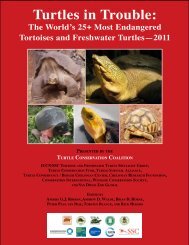WCS Annual Report 2012 - Wildlife Conservation Society
WCS Annual Report 2012 - Wildlife Conservation Society
WCS Annual Report 2012 - Wildlife Conservation Society
Create successful ePaper yourself
Turn your PDF publications into a flip-book with our unique Google optimized e-Paper software.
dear friends,<br />
A tiny animal experienced a gigantic milestone in <strong>2012</strong><br />
deep in the forests of Tanzania. The Kihansi spray toad,<br />
no bigger than a fingernail, may have beaten extinction.<br />
For the first time, an amphibian has been reintroduced<br />
into nature after it was declared extinct in the wild. The<br />
habitat of the Kihansi spray toad had been altered by the<br />
construction of a hydroelectric dam that eliminated the<br />
heavy natural mist – necessary for the animal’s survival –<br />
from the spray zone of the Kihansi Falls.<br />
At the request of the Tanzanian government, staff from<br />
the Bronx Zoo’s Department of Herpetology went to the<br />
Kihansi Gorge to collect the last remaining wild toads<br />
in November 2000. The toads were brought back to the<br />
United States, where the Bronx and Toledo Zoos worked<br />
out elaborate husbandry protocols with specific environmental<br />
parameters designed to meet the unique requirements<br />
of the toads.<br />
As the Tanzanian government set up artificial misting<br />
systems to replicate the animals’ original habitat, <strong>WCS</strong>’s<br />
Bronx Zoo and the Toledo Zoo bred toads in specially<br />
designed biosecure facilities in New York City and Toledo<br />
with the hope that they could one day be returned to their<br />
African home. It was zoological science and husbandry at<br />
their best. At 2 p.m. on October 30, <strong>2012</strong>, close to 2,000<br />
Kihansi spray toads were reintroduced back into the wild.<br />
In a truly extraordinary and historical moment, a missing<br />
piece of nature’s puzzle was put back into place.<br />
The story of the Kihansi spray toad is key to understanding<br />
what differentiates the <strong>Wildlife</strong> <strong>Conservation</strong> <strong>Society</strong><br />
from other conservation organizations. Since our founding<br />
in 1895, we have harnessed our expertise in zoological<br />
husbandry, conservation biology, and veterinary science<br />
to save wildlife and wild places. Now well into our second<br />
century, <strong>WCS</strong> continues to excel in all three disciplines to<br />
get the conservation results that count.<br />
Indeed, our history is packed with stories describing<br />
how we have combined our many strengths to fulfill our<br />
mission. In addition to our work this year to protect the<br />
Kihansi spray toad, we launched a bold strategy to save<br />
the 25 most endangered turtle species and we continued<br />
efforts that date back to the early 1900s to protect the<br />
American bison.<br />
We also continued our efforts to protect large wild<br />
places across the globe in areas as varied as Afghanistan,<br />
the Arctic, and Africa. As recently as December <strong>2012</strong>,<br />
we celebrated a major conservation success when the U.S.<br />
government, using <strong>WCS</strong> research and data, announced<br />
a final management plan for the National Petroleum<br />
Reserve-Alaska that balances wildlife conservation and<br />
energy development in the biggest public landscape in the<br />
United States. This effort will help ensure that the most<br />
important Arctic wetlands and wildlife corridors for caribou<br />
and migratory birds will be protected from development.<br />
<strong>WCS</strong> continued to address the global crisis in wildlife<br />
trafficking on several fronts. In Mozambique we negotiated<br />
an agreement with the government to co-manage the<br />
Niassa National Reserve to combat elephant poaching in<br />
that country’s largest protected area. In multiple landscapes,<br />
we deployed a new wildlife protection initiative,<br />
SMART (the Spatial Monitoring and Recovering Tool),<br />
which helps park and community rangers fight trafficking<br />
by identifying poaching hotspots, improving rapid<br />
response measures, and calculating anti-poaching efforts<br />
in order to maximize results.<br />
At the same time, <strong>WCS</strong> conservationists have been<br />
successful in places like Zambia in helping former poachers<br />
find alternative livelihoods that generate income for<br />
their families while relieving pressure on local fauna.<br />
We love to tell stories describing how <strong>WCS</strong>’s components<br />
complement one another. We are especially pleased to<br />
explain how zoos are more important than ever as partners<br />
in global field conservation. As wild landscapes shrink<br />
and disappear, the knowledge and skills we have developed<br />
in our zoos are vital to the care and management of<br />
wildlife forced to live in ever smaller spaces. The Bronx<br />
Zoo has been a leader in developing this know-how as<br />
zoos evolve into scientific powerhouses and strategic settings<br />
to raise assurance colonies of threatened species.<br />
Other distinguishing characteristics of <strong>WCS</strong> have been<br />
the vision, commitment, and creativity of our leaders<br />
through the decades – beginning with New York Zoological<br />
<strong>Society</strong> founding director William Hornaday and<br />
continuing to the present. This year marked a major transition<br />
for <strong>WCS</strong> as Dr. Steven Sanderson retired after leading<br />
our organization for more than a decade. During his<br />
tenure, Steve expanded our global conservation program<br />
fivefold and shepherded a magnificent renaissance at the<br />
Bronx Zoo. It was his leadership that helped knock down<br />
the walls between our zoos/aquarium and our field work<br />
– enabling us to take on challenges and create amazing<br />
success stories like the Kihansi spray toad.<br />
We take inspiration from our past as we recommit ourselves<br />
to protecting our threatened planet for generations<br />
to come. We invite you to join us in this effort.<br />
Ward W. Woods<br />
Chair of the Board<br />
Cristián Samper<br />
President and CEO<br />
7<br />
president/ceo & chair LEtter







![RaLand / SeaScape [PDF] - Wildlife Conservation Society](https://img.yumpu.com/49974326/1/190x245/raland-seascape-pdf-wildlife-conservation-society.jpg?quality=85)









